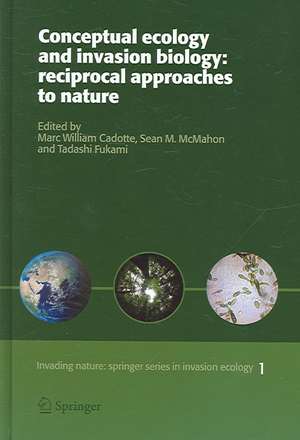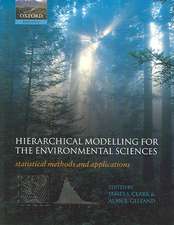Conceptual Ecology and Invasion Biology: Reciprocal Approaches to Nature: Invading Nature - Springer Series in Invasion Ecology, cartea 1
Editat de Marc W. Cadotte, Sean M. McMahon, Tadashi Fukamien Limba Engleză Hardback – 9 mai 2006
In this edited volume, global experts in ecology and evolutionary biology explore how theories in ecology elucidate the invasion processes while also examining how specific invasions informs ecological theory. This reciprocal benefit is highlighted in a number of scales of organization: population, community and biogeographic, while employing example invaders in all major groups of organisms and from a number of regions around the globe. The chapters in this volume utilize many of the cutting edge observational, experimental, analytical and computational methods used in modern ecology. Through merging conceptual ecology and invasion biology we can obtain a better understanding of the invasion process while also developing a better understanding of how ecological systems function.
| Toate formatele și edițiile | Preț | Express |
|---|---|---|
| Paperback (1) | 1390.89 lei 6-8 săpt. | |
| SPRINGER NETHERLANDS – 9 mai 2006 | 1390.89 lei 6-8 săpt. | |
| Hardback (1) | 1238.56 lei 6-8 săpt. | |
| SPRINGER NETHERLANDS – 9 mai 2006 | 1238.56 lei 6-8 săpt. |
Preț: 1238.56 lei
Preț vechi: 1510.44 lei
-18% Nou
Puncte Express: 1858
Preț estimativ în valută:
236.99€ • 247.44$ • 196.15£
236.99€ • 247.44$ • 196.15£
Carte tipărită la comandă
Livrare economică 04-18 aprilie
Preluare comenzi: 021 569.72.76
Specificații
ISBN-13: 9781402041570
ISBN-10: 1402041578
Pagini: 524
Ilustrații: XVIII, 487 p.
Dimensiuni: 210 x 297 x 37 mm
Greutate: 1.04 kg
Ediția:2006
Editura: SPRINGER NETHERLANDS
Colecția Springer
Seria Invading Nature - Springer Series in Invasion Ecology
Locul publicării:Dordrecht, Netherlands
ISBN-10: 1402041578
Pagini: 524
Ilustrații: XVIII, 487 p.
Dimensiuni: 210 x 297 x 37 mm
Greutate: 1.04 kg
Ediția:2006
Editura: SPRINGER NETHERLANDS
Colecția Springer
Seria Invading Nature - Springer Series in Invasion Ecology
Locul publicării:Dordrecht, Netherlands
Public țintă
ResearchCuprins
Introduction, history and terminology.- Tracking the tractable: using invasion to guide the exploration of conceptual ecology.- Darwin to Elton: early ecology and the problem of invasive species.- Invasion biology 1958-2005: the pursuit of science and conservation.- Invasiveness in exotic plants: immigration and naturalization in an ecological continuum.- Populations at play.- Density dependence in invasive plants: demography, herbivory, spread and evolution.- Stochasticty, nonlinearity and instability in biological invasions.- Local interactions and invasion dynamics: population growth in space and time.- A guide to calculating discrete-time invasion rates from data.- The role of evolutionary genetiocs in studies of plant invasions.- Unwlcomed visitors: species interactions.- Contact experience, alien-native interactions, and their community consequences: a theoretical consideration on the role of adaptation in biological invasion.- Use of biological invasions and their control to study the dynamics of interacting populations.- Invasibility of seed prdators on synchronized intermittent seed production of host plants.- Invasion and the regulation of plant populations by pathogens.- Exploring the relationship between nichie breadth and invasion success.- Interactions between invasive plants and soil ecosystem: positive feedbacks and their potential to persist.- Invasion biology as a community process: messages from microbial microcosms.- Large-scale consequences and pattern of invasions.- Understanding invasions in patchy habitats through metapopulation theory.- Competition and the assembly of introduced bird communities.- Room for one more? Evidence for invasibility and saturation in ecological communities.- Ther biogeography of naturalized species and the species-arearelationship: reciprocal insights to biogeography ans invasion biology.- Synthesis.- Linking scale dependent processes in invasions.
Caracteristici
Highlights how theory can be used to understand species invasions Examines invasions across many spatial and temporal scales Utilizes many of the most up-to-date experimental, analytical and computational methods























